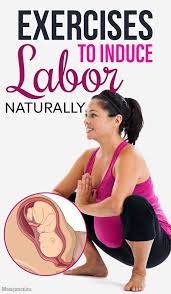Exercises to Induce Labor
As an expectant mother approaching her due date, you may be eager to kickstart the labor process naturally. While it’s important to consult with your healthcare provider before trying any methods to induce labor, certain exercises can help prepare your body for childbirth and potentially encourage labor to begin.
Walking
Walking is a low-impact exercise that can help stimulate contractions and encourage the baby to move into the birth canal. Take a brisk walk around your neighborhood or a nearby park to get your body moving.
Squats
Squats can help open up the pelvis and encourage the baby to descend lower into the birth canal. Stand with your feet shoulder-width apart and slowly lower yourself into a squatting position, keeping your back straight. Hold for a few seconds before standing back up.
Pelvic Tilts
Pelvic tilts can help strengthen your pelvic muscles and prepare them for labor. Lie on your back with your knees bent and feet flat on the floor. Slowly tilt your pelvis upward, engaging your core muscles, then release back down.
Kegel Exercises
Kegel exercises can help strengthen the pelvic floor muscles, which are important for labor and postpartum recovery. To perform Kegels, contract and hold the muscles you would use to stop the flow of urine, then release.
Prenatal Yoga
Prenatal yoga combines gentle stretching, breathing techniques, and relaxation exercises that can help prepare your body for childbirth. Certain yoga poses may also help encourage optimal fetal positioning for labor.
Remember that while these exercises may help prepare your body for labor, they are not guaranteed to induce labor or bring about immediate results. It’s essential to listen to your body, stay hydrated, and consult with your healthcare provider before trying any new exercise routines during pregnancy.
9 Effective Exercises to Naturally Induce Labor: From Walking to Deep Breathing Techniques
- Walking regularly
- Swimming or water aerobics
- Pelvic tilts and circles
- Squatting exercises
- Prenatal yoga or stretching routines
- Kegel exercises
- Light cardio like stationary cycling
- Dancing or gentle hip movements
- Deep breathing exercises
Walking regularly
Walking regularly is a gentle yet effective way to potentially induce labor as your due date approaches. Taking brisk walks can help stimulate contractions and encourage the baby to move into the birth canal. It also promotes good circulation and can help prepare your body for childbirth. Remember to listen to your body, stay hydrated, and consult with your healthcare provider before incorporating walking or any new exercise routine into your pregnancy regimen.
Swimming or water aerobics
Engaging in swimming or water aerobics can be a gentle and effective way to stay active during pregnancy and potentially help induce labor. The buoyancy of water reduces the impact on your joints while providing resistance for a full-body workout. Swimming and water aerobics can help improve circulation, strengthen muscles, and promote relaxation, all of which are beneficial for preparing your body for childbirth. The weightlessness in water can also help alleviate the discomfort of late pregnancy and encourage the baby to move into an optimal position for labor. As always, consult with your healthcare provider before starting any new exercise routine during pregnancy to ensure it is safe for you and your baby.
Pelvic tilts and circles
Pelvic tilts and circles are gentle exercises that can help strengthen the pelvic muscles and promote flexibility in the pelvic area, which may aid in preparing the body for labor. By performing pelvic tilts, where you tilt your pelvis upward while lying on your back, and circles, where you move your pelvis in a circular motion, you can improve blood flow to the pelvic region and potentially encourage optimal positioning of the baby for childbirth. These exercises can also help alleviate lower back pain and discomfort commonly experienced during pregnancy. Remember to listen to your body and consult with your healthcare provider before incorporating any new exercises into your routine, especially as you approach your due date.
Squatting exercises
Squatting exercises are beneficial for pregnant women as they help open up the pelvis and encourage the baby to descend lower into the birth canal. By practicing squats, expectant mothers can strengthen their pelvic muscles and prepare them for the labor process. The simple act of squatting can also improve flexibility and promote better alignment of the baby for delivery. It is important to perform squats with proper form and technique to maximize their effectiveness in aiding labor progression.
Prenatal yoga or stretching routines
Engaging in prenatal yoga or gentle stretching routines can be beneficial for expectant mothers looking to prepare their bodies for labor. These exercises focus on promoting flexibility, strength, and relaxation, which are essential components for a smoother childbirth experience. Prenatal yoga and stretching can help alleviate tension in the body, improve circulation, and encourage optimal fetal positioning. By incorporating these practices into your routine, you not only support your physical well-being but also cultivate a sense of calm and mindfulness as you approach the final stages of pregnancy. Remember to consult with your healthcare provider before starting any new exercise regimen during pregnancy to ensure it is safe for you and your baby.
Kegel exercises
Kegel exercises are a beneficial way for expectant mothers to strengthen their pelvic floor muscles in preparation for labor and delivery. By engaging and toning these muscles through regular Kegel exercises, pregnant individuals can potentially experience improved control during childbirth and aid in postpartum recovery. These exercises involve contracting and releasing the pelvic floor muscles, which not only support the bladder, uterus, and bowels but also promote better circulation in the pelvic area. Incorporating Kegel exercises into a prenatal fitness routine can help pregnant individuals feel more empowered and connected to their bodies as they approach childbirth.
Light cardio like stationary cycling
Engaging in light cardio exercises such as stationary cycling can be a beneficial way to prepare your body for labor. Stationary cycling provides a low-impact workout that helps improve cardiovascular endurance and strengthen leg muscles, which can be advantageous during childbirth. The gentle rhythmic motion of cycling can also help promote blood circulation and release endorphins, which may contribute to relaxation and stress reduction. However, it’s important to consult with your healthcare provider before starting any new exercise routine, including stationary cycling, especially as you approach your due date.
Dancing or gentle hip movements
Engaging in dancing or gentle hip movements can be a fun and effective way to potentially induce labor naturally. The rhythmic movements involved in dancing or hip exercises can help loosen the pelvic joints and encourage the baby to move down into the birth canal. Whether swaying to music, practicing gentle hip circles, or trying out specific dance routines designed for pregnant women, these activities can not only promote relaxation but also stimulate contractions. Remember to listen to your body, choose movements that feel comfortable, and consult with your healthcare provider before incorporating any new exercise routines during pregnancy.
Deep breathing exercises
Deep breathing exercises can be a valuable tool for expectant mothers looking to induce labor naturally. By practicing deep breathing techniques, you can help relax your body, reduce stress and anxiety, and promote optimal oxygen flow to both you and your baby. Deep breathing exercises can also help you focus your mind and connect with your body, preparing you for the physical demands of childbirth. Incorporating deep breathing into your daily routine can not only support your overall well-being during pregnancy but also potentially assist in kickstarting the labor process when the time is right.



